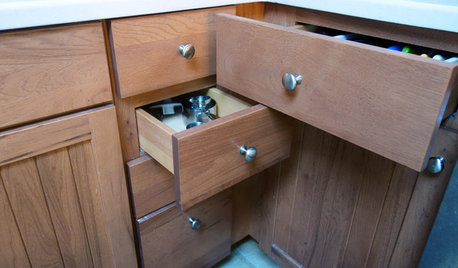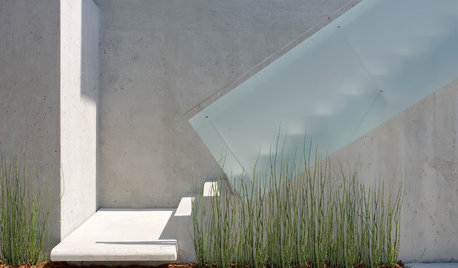Watering deeply (an inch), but the math does not add up?
tye22tye
8 years ago
Featured Answer
Sort by:Oldest
Comments (57)
danielj_2009
8 years agoUser
8 years agoRelated Discussions
How much does you water bill go up in the summer due to gardening
Comments (26)Thanks for all the replies. As long as you are talking about other utilities, here is my rundown for all my utilities and car insurance in the Ohio Valley. BTW, I really like the $6 per month water bill person! We pay about $25 for 2 months of trash pickup.(just went up 18%) We pay $1800 per year in property tax on our $190,000 house Our water bill averages about $64 with college kid and $45 per month without kid and covers our sewage as well. Car insurance is pretty cheap. About $400 to $450 per year for a new car under $20,000 with full coverage and $500D We use NG to heat. We keep the thermostat set at 64 at night and keep the heat off during the day. House gets down into the low 50's in daytime. I usually turn on the heat around 9 PM and shut it down at 8 or 9 am. To heat this way cost us $250 a month to heat a modern 2400 sq ft house. (including garage as it has some water pipes in its ceiling). We've been told our gas bill will go up almost 30% this season. Summer gas bill is the minim about $24 per month. As the NG runs out prices for all heating methods will only keep climbing. Even the coal will run out someday. Winter '08 they said they had a coal crisis brewing in China. Some say water will peak too and we had better know how to do the 'rain catchment' thing....See MoreSwitched to watering deeply and infrequently
Comments (7)That might have been too sudden a change for the shallow roots. The brown areas are the KBG in normal summer dormancy. I'm trying to remember if we've talked about weaning grass off of a daily regimen to a weekly one. You should not do it cold turkey. What you should have done was back off on the frequency and move up on the duration gradually. For example you were watering on days 1, 3, and 5. Then on day 1 you would water twice as long as you normally did and then skip the next normal watering day. But watch it carefully! Then on the next day (day 4) repeat the watering timing from day 1 and see if you can skip to day 6 - and watch it carefully. Then double the time again and skip 3 (or 4) days. What this does is deepen the moisture in the soil and allows the roots of the grass to explore deeper into the soil to pick up that moisture further down. It also gives the soil microbes a chance to explore deeper down. Once you have deep roots down in the cooler/deeper soil, the KBG will not go dormant as soon or stay dormant as long in the summer. If you find you have runoff, try applying some clear shampoo at a rate of 3 ounces (or more) per 1,000 square feet once now and repeat in 2 weeks. That will allow the water to penetrate deeper. You can repeat this as often as you like or need to. I remember reading some of your earlier posts but I can't remember where you live. Was it back up the freeway from LA toward the San Fernando Valley?...See MoreDo own root roses need to be planted deeply too?
Comments (11)The only time I plant own root roses much deeper than they are in the pot is when I have a single stem on the lower portion, with branching above it. I'll plant it deep enough so the lower portion of the branching is below the soil surface. This promotes rooting on the single stem and on the lower portion of the branched area. It also provides for better support of the bush. With own roots that are already planted with the lower branching portion covered, I don't plant any deeper than an inch more than it was in the pot. When planting deeper, expect a slower recovery until the bush grows more roots. It won't be stressed if transplanted properly, but won't do much for awhile....See MoreWatering volume per planting (rather than by 'inches')
Comments (5)Hi Plantslayer, An inch of rain is exactly that, water that is one inch deep. One inch of rainfall equals 4.7 gallons of water per square yard or 22,650 gallons of water per acre! A mature tomato plant's root will cover more than a square yard of space, so it is going to need about 5 gallons of water a week, and you did not say how often you were applying that "about 1 gallon per plant space per watering, applied slowly enough to soaks in without running off". If you are doing that every day or so, you'd have about 7 gallons per week, but what you would be doing would be watering shallowly and training your tomatoes to grow roots near the surface. Not an ideal solution. I'd prefer that my tomatoes had a cubic yard of root space rather than a square yard. Now if you can put 5 gallons of water on each plant on a weekly basis, that might work except for the fact that nature abhors a vaccuum! If you put 5 gallons of water in a square foot of space, it is going to naturally migrate to the drier areas. You can't just water to a certain point without some physical barrier (such as a container.) So, 5 gallons a week just at the stem of a tomato is going to be insufficient. The area that normally acts as a resevoir will instead act like a sponge and draw the moisture away from your plants if it is drier then the root area is. For in gound plants, you need an inch of water on their roots and the surrounding area. (Probably at least 3 to 4 feet all around the plants.) So probably more like 10 gallons of water per plant. Betsy...See Moredanielj_2009
8 years agodchall_san_antonio
8 years agoPaul G
8 years agoyardtractor1
8 years agoUser
8 years agolast modified: 8 years agodanielj_2009
8 years agotye22tye
8 years agoPaul G
8 years agotye22tye
8 years agoUser
8 years agolast modified: 8 years agodanielj_2009
8 years agolast modified: 8 years agodanielj_2009
8 years agotye22tye
8 years agolast modified: 8 years agoUser
8 years agoPaul G
8 years agotye22tye
8 years agolast modified: 8 years agonewtolawncare Scranton 6a
8 years agoyardtractor1
8 years agotye22tye
8 years agolast modified: 8 years agoyardtractor1
8 years agoUser
8 years agoyardtractor1
8 years agolast modified: 8 years agoUser
8 years agodchall_san_antonio
8 years agoUser
8 years agolast modified: 8 years agodanielj_2009
8 years agoUser
8 years agodanielj_2009
8 years agotye22tye
8 years agolast modified: 8 years agodanielj_2009
8 years agoyardtractor1
8 years agotye22tye
8 years agoUser
8 years agolast modified: 8 years agoUser
8 years agoyardtractor1
8 years agolast modified: 8 years agoyardtractor1
8 years agoUser
8 years agolast modified: 8 years agoyardtractor1
8 years agoAdam Bray
8 years agolast modified: 8 years agoyardtractor1
8 years agotye22tye
8 years agolast modified: 8 years agodanielj_2009
8 years agodanielj_2009
8 years agodanielj_2009
8 years agotye22tye
8 years agoyardtractor1
8 years agolast modified: 8 years agodanielj_2009
8 years agoyardtractor1
8 years agolast modified: 8 years ago
Related Stories

INSIDE HOUZZHow Much Does a Remodel Cost, and How Long Does It Take?
The 2016 Houzz & Home survey asked 120,000 Houzzers about their renovation projects. Here’s what they said
Full Story
GARDENING GUIDESEssential Watering Tips for Your Edible Garden
To give your edible plants just what they need, check out these guidelines for how, when and how much to water
Full Story
GREEN BUILDINGJust Add Water: Rain Barrel Magic
Take your rainwater storage from practical to beautiful with a new breed of design-friendly rain barrels
Full Story
GREAT HOME PROJECTSHow to Add a Solar Water Heater
Lower energy bills without a major renovation by putting the sun to work heating your home’s water
Full Story
THE HARDWORKING HOMECES 2015: Inching Toward a Smarter Home
Companies are betting big on connected devices in 2015. Here’s a look at what’s to come
Full Story
REMODELING GUIDESBathroom Workbook: How Much Does a Bathroom Remodel Cost?
Learn what features to expect for $3,000 to $100,000-plus, to help you plan your bathroom remodel
Full Story
FUN HOUZZ10 Truly Irritating Things Your Partner Does in the Kitchen
Dirty dishes, food scraps in the sink — will the madness ever stop?
Full Story
LANDSCAPE DESIGNDoes Your Landscape Need a Little ‘Cosmic Latte’?
Beige — the color of the universe — can be both building block and backdrop in a contemporary garden
Full Story
EDIBLE GARDENSHow to Add an Apple Tree to Your Edible Garden
Readily available, beautiful and fragrant, apple trees offer four-season interest along with crisp, juicy fruit
Full Story
BATHROOM DESIGNSee the Clever Tricks That Opened Up This Master Bathroom
A recessed toilet paper holder and cabinets, diagonal large-format tiles, frameless glass and more helped maximize every inch of the space
Full Story





Paul G